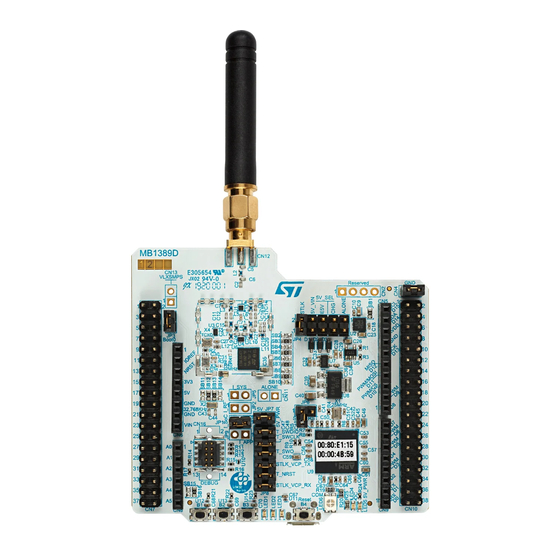
STMicroelectronics STM32WL5 Series MCU Manuals
Manuals and User Guides for STMicroelectronics STM32WL5 Series MCU. We have 1 STMicroelectronics STM32WL5 Series MCU manual available for free PDF download: Reference Manual
STMicroelectronics STM32WL5 Series Reference Manual (1450 pages)
Advanced Arm-based 32-bit MCUs with Sub-GHz Radio Solution
Brand: STMicroelectronics
|
Category: Microcontrollers
|
Size: 28 MB
Table of Contents
-
-
Glossary60
-
CPU2 Boot65
-
SRAM Erase66
-
Introduction71
-
Interrupts85
-
Empty Check99
-
Introduction117
-
RSSLIB Functions117
-
FLASH Interrupts127
-
FLASH Registers129
-
(Flash_Ipccbr)144
-
(Flash_Srrvr)150
-
Transmitter157
-
Receiver158
-
Rf-Pll159
-
Lora Modem161
-
Lora Framing163
-
FSK Modem165
-
Generic Framing166
-
MSK Modem166
-
BPSK Modem168
-
BPSK Framing169
-
Calibration Mode172
-
Sleep Mode172
-
Startup Mode172
-
Standby Mode173
-
(Subghz_Paocpr)221
-
Power Supplies228
-
CPU2 Boot239
-
Low-Power Modes241
-
Run Mode249
-
Table 47. Lprun250
-
Sleep Mode252
-
Stop 0 Mode254
-
Stop 1 Mode256
-
Stop 2 Mode257
-
Standby Mode259
-
Shutdown Mode261
-
PWR Registers263
-
PWR Register Map283
-
Power Reset286
-
Reset286
-
System Reset286
-
Clocks288
-
PKA SRAM Reset288
-
HSI16 Clock294
-
MSI Clock294
-
Pll295
-
LSE Clock296
-
LSI Clock297
-
SPI2S2 Clock299
-
ADC Clock300
-
RTC Clock300
-
Timer Clock300
-
True RNG Clock301
-
Watchdog Clock301
-
Preloaded)900
-
(Tim16/17)932
-
IDLE = 50 Μs)1086
-
(M Bits = 00)1144
-
(M Bits = 01)1145
-
(M Bits = 00)1146
-
FIFO Disabled)1162
-
FIFO Disabled)1226
-
Figure 368. I1284
Advertisement
Advertisement
Related Products
- STMicroelectronics STM32WLEx
- STMicroelectronics STM32WL55 Series
- STMicroelectronics STM32WL54 Series
- STMicroelectronics STM32L151UCY6
- STMicroelectronics STM32L152QCH6
- STMicroelectronics STM32F469I-DISCO
- STMicroelectronics STM32F050F4
- STMicroelectronics STM32F050K4
- STMicroelectronics STM32F050G6
- STMicroelectronics STM32L151QCH6
